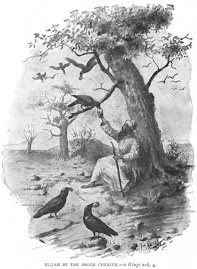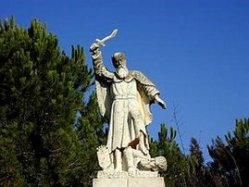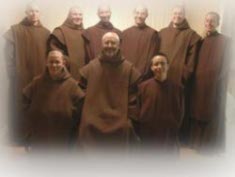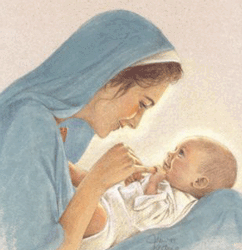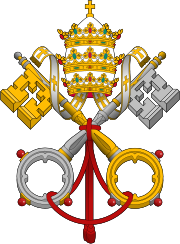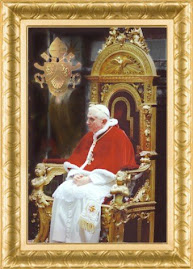St Mary Magdalene de Pazzi is one of the greatest mystics of Carmelite Order of ancient observance who was favoured by God with extraoridnary graces. Therefore, I will present some posts dedicated to her life, spirituality and prayers for the edification of souls devouted to Carmel. St Mary Magdalene and St Teresa are the most prominent mystics of the Renaissance era. However, unlike the Spanish founder of Discalced Carmelites, the Saint of Florence has never received the recognition she deserves. It might be due to particular attitude of Italian theologians who traditionally excluded mystical literature from their writings. The exception was St Catherine of Siena and later on, St Angela of Foligno. Only a small group of religious writers had published a complete editions of her work in the early sixties. There is no English translations of the most accurate biographies of the Saint, the knowledge of her spiritual experiences we have from the reports of her ecstasies faithfully made by the nuns of her convent who witnessed St Mary Magdalene frequent raptures and were supposed to write down all the words she uttered and her every movement and act. These reports were edited in seven volumes from 1960 to 1966. The only English translation is a compilation of fragments from "The Complete Works of St Mary Magdalene de Pazzi" and includes "The Forty days", "The Dialogues", "The Regeneration of the Church" and "The Probation". The book is edited by A. Maggi and E. Ann Matter and appeared in the series of The Classics of Western Spirituality. Today I will present the information about Saint life.

Sister Mary Magdalen was born in the city of Florence on the 2nd day of April, 1566. Her father was named Sire Camillus di Geri de'Pazzi, and her mother Magdalen Mary, daughter of Sire Lawrence Buondelmonti. At Baptism she received the name of Catherine. On the following day, April 3, at 10 o'clock in the morning, she received Baptism in the oratory of St. John the Baptist. On Feb. 25, 1574, she entered the monastery of Little St. John of the Knights for the first time as a pupil, and was entrusted to the care of her maternal aunt, Sister Alexandra Buondelmonti. On March 25, 1576, at the age of ten, she received Holy Communion for the first time, in the church of Little St. John, which at that time was served by the Jesuits. On April 19 she made a vow of perpetual virginity to God. Towards evening on the feast of St. Andrew the Apostle, Nov. 30, 1578, she had her first ecstasy, in the presence of her mother, Lady Mary, while she was in the garden of their villa of Parugiano near Prato. When Sire Camillus de'Pazzi, father of the saint, was sent as commissary to Cortona by the grand duke of Tuscany, Francis I, Catherine, on March 16, 1580, was again "placed in keeping" at the monastery of the Ladies of Little St. John. This was done in following the advice of the Jesuit Peter Blanca, on condition that she would be permitted to receive Holy Communion on all Sundays and holydays, an unusual practice in those times. On the feast of the Ascension, while she was still at Little St. John's, she experienced an excess of love and an extraordinary understanding of the greatness of God and of His grace, in 1581 she left the monastery of Little St. John and returned to her family. On Aug. 14, 1582, she entered the monastery of the Carmelite nuns of St. Mary of the Angels for a fifteen-day stay, in order to become acquainted with the rule and to see if it would correspond to the divine call and to her particular tendencies. The rule fitted her intimate desires; and so she decided to choose this monastery. She was aided in her choice by the fact that the Carmelites, by exceptional permission, could receive Holy Communion every day. On Dec. 1, 1582, the Saturday preceding the first Sunday of Advent, Catherine crossed for ever the threshold of the cloister and entered to become a nun among the Carmelites of St. Mary of the Angels. On Dec. 8, the chapter of the monastery unanimously accepted the new postulant. On Jan. 3, 1583, Catherine de'Pazzi was clothed in the Carmelite habit and took the name of Sister Mary Magdalen, thus beginning her year of novitiate. During the Advent of that year she experienced an excess of love like that which she had had as a child in the villa of Parugiano. During the first days of March of 1584 a mysterious malady manifested itself: "one morning she was overcome by a high fever together with a harsh cough, with severe pains in the area of her chest and below her ribs... Day and night she constantly remained seated on her bed, without ever being able to lie down, because of the vehemence of her cough. She hardly ever slept or, indeed, did so little that it is something incredible. The same was true of her eating, so that she was wasting away little by little... After she had been sick for two months, the doctors gave her up for lost, whence the superiors /the prioress, Sister Victoria Contugi, and the mistress of novices, Sister Evangelist del Giocondo/ decided to have her make her holy profession. This was done on the 27th day of May, 1584, during the morning of the feast of the Most Holy Trinity" . Mary Magdalen made her profession "on a cot arranged before the altar of the Virgin" and was then immediately brought back to the infirmary. From that moment on there began a surprising period of ecstasies; every day after Communion she remained ecstatic for two or three hours. Sometimes she had new and repeated excesses of love during the day as well, with the renewal of the divine favors. The experience lasted uninterruptedly for forty days, during which the following mystical phenomena occurred and should be remembered: a vision of the drama of the Passion (especially noteworthy is that of June 8), the exchange of her heart with that of Jesus (June 10), the first invisible impression of the stigmata (June 28). Moreover, on July 6 she received the crown of thorns from Our Lord, in the presence of St. Catherine of Siena and of St. Augustine; and she was to suffer the mysterious pain of the crown for the rest of her life. She was cured on July 16 at the intercession of the Blessed Mary Bagnesi; and subsequently the life of Mary Magdalen became a succession of visions, ecstasies, other mystical phenomena, penances and trials. On the evening of March 24, 1585, the vigil of the Annunciation, St. Augustine wrote the words «Verbum caro factum est» /The Word was made flesh/ on her heart. On April 15 the invisible stigmata were imprinted on her soul permanently; on the 28th she received a ring from Jesus, the seal of her mystical espousal with Him. On Friday, May 17, she had the longest of any of her ecstasies until then. It began on the afternoon of Friday and was prolonged for forty hours, until the following Sunday morning. On the 21st she received the Lord's command to take only bread and water as nourishment, except on Sundays and holydays, on which days she would be able to take "Lenten foods". Furthermore, Jesus ordered her to rest only five hours a day, on a straw mattress, in satisfaction, for the offenses that are committed against Him.

On the vigil of Pentecost, June 8, 1585, began the second great cycle of esctasies, which went on uninterruptedly for eight days. «During all this time she constantly remained rapt in an excess of mind, both day and night, except that for the period of about two hours each day that was granted her to recite the office, take some little bit of food and a bit of rest. Seven times she received the Holy Spirit in different forms, each morning at the hour of Terce (9 o'clock)....On June 16, the feast of the Most Holy Trinity, her great trial began; called "a den of lions", it was to last for five years. The saint had already spent a year in desolating spiritual aridity when, on July 20, 1586, "to the great wonder" of the nuns, she suddenly went into ecstasy while she was reciting the divine office. But this ecstasy was one of particular "affliction and sorrow". God communicated to her that He wished to alleviate the pressure of temptation and to mitigate the trial, "until October", in order to give her light and the ability to undertake a great work: "the renovation of the Church and particularly of religious" . From that day on Mary Magdalen had similar ecstasies from time to time. In the month of August she spent four days and four nights in continuous rapture, "except for the time when she said the divine office, ate a bit of bread and drank a bit of water ... which was only a short while". God revealed to her that the Church had need of reform. All were called to contribute their share. She, furthermore, had a special mission: to remind religious and the higher dignitaries of the Church of the urgency of their task. The saint trembled at this revelation, because it contrasted so enormously with her humility; she would have preferred death a thousand times. Fearing that she was deceived, she spoke of the matter to her superiors and asked counsel of several religious known for their prudence and holiness of life, such as Father Angelus, the Dominican, and Father Fabbrini, the Jesuit. All encouraged her to follow God's commands without hesitation, since these commands were clear, decisive, and repeated; therefore, it was absolutely necessary that she obey. And for this reason "in her abstraction of mind, she wrote some letters, in favor of such a renewal, to the Supreme Pontiff and to other prelates and servants of God".
In Oct. of 1586 the saint left the novitiate. Her brother Alamanno died on July 14, 1587; and she saw his soul painfully suffering in purgatory. On Feb. 25, 1588, she contemplated Jesus in His passion, and from Him she received the singular gift of "the bundle of His passion, as He gave it to St. Bernard". On Nov. 25 of the same year the dire trials to which she was exposed (the temptations to leave the convent and to kill herself) reached their peak. On Sept. 30, 1589, Mother Evangelist del Giocondo was elected mistress of novices and Sister Mary Magdalen received the charge of assistant mistress. On Easter Sunday, April 22, 1590, the Lord asked her to make "another Lent of fifty days, and she fasted in her usual way, on only bread and water", until the feast of the Holy Spirit (June 10). On this feast she was finally freed from the "den of lions". As her reward, she received great gifts and divine communications. On Aug. 24, 1590, her mother, Lady Mary Buondelmonti; died. Mary Magdalen contemplated her as "happy and content in the pains of purgatory", and understood what great joy had been prepared for her in paradise because of the good and the charity that she had done to her neighbor during her lifetime. Fifteen days later, on Sept. 7, she saw her mother join the saints in paradise. In 1591 the confessor and administrator of the monastery, Father Augustine Campi da Pontremoli, died; Canon Francis Benvenuti succeeded him. On March 26, 1592, in a prolonged ecstasy, Mary Magdalen shared in the sorrows of the passion, as she had already done seven years before. On May 3, 1592, the year in which she was entrusted with the office of sacristan, she had a great excess of love: she ran through the monastery, she rang the bells to call all souls "to love Love" . On May 1, 1595, she asked the Lord for "naked suffering". This request of the saint is personally attested to by Mother Evangelist del Giocondo, by Sister Pacifica del Tovaglia, by Sister Mary Christine Pazzi, and by Sister Mary Grace Pazzi, the saint's niece. But the Lord was to grant her this grace only nine years later. In this same year, 1595, she was elected mistress of the newly professed; and in the chapter of Oct. 2, 1598, she was chosen as mistress of novices. With June 24, 1604, on which date she remained in rapture all day, the ecstasies ended and the period of "naked suffering" began, to continue until her death. Contrary to her desire, in the elections of 1604 the chapter elected her sub-prioress. A short while later she became ill; this was the beginning of three years of physical and moral sufferings never before experienced by her. After Francis Benventi died in 1605, Father Vincent Puccini, the first and principal biographer of the saint, was chosen confessor of the monastery. On May 13, 1607, Mary Magdalen received the anointing of the sick; at eight o'clock of Friday, May 25, her agony began and at two o'clock in the afternoon she died. The sisters who surrounded her recited the Creed of St. Athanasius, the profession of faith in the Trinity that had made the saint ecstatic from the first years of her life. A year after her death the nuns obtained permission to bring the remains of their saintly sister into the cloister, and Father Puccini presided at the exhumation of the body. As soon as the coffin had been opened, this body appeared fresh, whole, flexible. Only the clothing was wet, because the place where she had been buried was humid, and water had oozed through. In 1611 the processes for beatification were begun, after many miracles had been granted through her intercession. All the religious who had known her were invited to testify, and this they did "in a convincing and precise manner". Noteworthy for their extent and content were the testimonies of Mother Evangelist del Giocondo and of Sister Pacifica del Tovaglia, an intimate childhood friend of the saint. Pope Urban VIII beatified Sister Mary Magdalen on May 8, 1626; and in 1662 the process for canonization was opened. Pope Clement IX proclaimed her a saint on April 28, 1669.
after carmelnet "St Mary Magdalene de Pazzi. Life" - a compilation of informations taken from various sources made by Herman Ancilli




